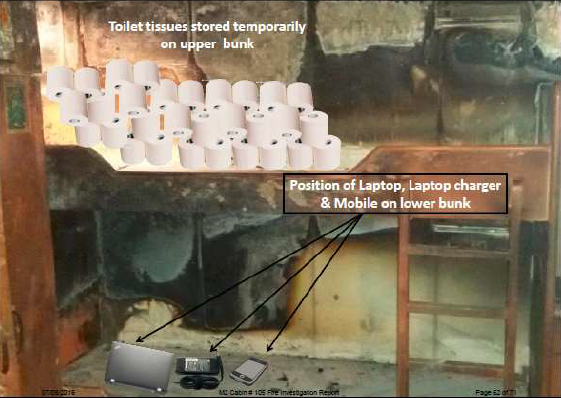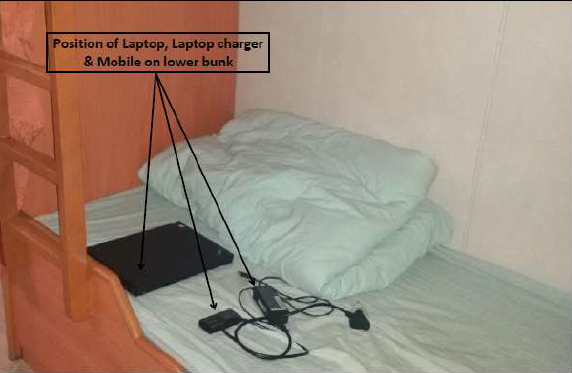Fire in vessel accommodation – Overheating notebook computer
A member has reported an incident in which there was a fire in the accommodation of an offshore support vessel. The vessel systems were unaffected by the fire and there were no injuries caused by the fire or the subsequent actions to extinguish the blaze. Damage was limited to the walls, ceiling, furniture and furnishings of the cabin in which it occurred.


Sequence of events:
19:00 – Catering crew finished shift;
19:15-19:20 (approximately) – Notebook computer observed left on the bunk bed in cabin, with the lid closed;
20:15 – Fire alarm sounded from the cabin which had been vacated at approximately 20:00. Upon the alarm being raised the Bridge despatched the AB/crane driver who was on deck to check on the reason for the alarm. Door to the corridor was opened and the corridor was found to be full of smoke – this information was relayed to the Bridge. Bridge personnel activated the general alarm and mustered all personnel. The accommodation ventilation air conditioning was shut down as per standard operating procedure in the event of a fire;
20:19-20:31 – Fully dressed fire team attended to the fire. The door was checked for excessive heat and upon opening the door to the cabin it was discovered that the fire was by now mostly heat and smoke; the air ingress caused by the door opening had caused the fire to flare up. Dry powder fire extinguishers were used to tackle the blaze and was extinguished in a matter of seconds. A second fire team did not attempt to locate the wall mounted fire hose cabinet in the alleyway because of the thick smoke, so a fire hose was run from the fire pump supplied connection on the port side of the main deck to provide boundary cooling for the room and the corridor. Nearby vessels and installations were contacted to provide assistance;
20:31 – Bridge were notified that the fire was extinguished;
20:33 – The Chief Officer and 2nd Officer checked the cabin, and adjacent cabins, for hot spots. Ventilation of the cabins had begun in order to clear the smoke. The remains of the notebook computer were seen, still on a bunk, along with the power supply.
Our members’ investigation revealed the following:
- The occupant of the cabin had borrowed the notebook computer and was not an experienced computer user;
- The notebook computer had been fully charged when he turned it on so he didn’t plug it in to charge it;
- It appears that the notebook computer was inadvertently turned on whilst laying on a bunk bed, and this reduced the efficiency of the cooling fan which caused the computer to overheat;
- The integrity of the scene, with regard to investigation, was necessarily compromised after the incident;
- The remains of the notebook computer were at the heart of the fire, but had been rendered almost totally unrecognisable after being subjected to the fire and the water spray – distinctly heavy burning to the mattress and the wood underneath was evident at the notebook computer location;
- The remains of the computer along with other debris were scraped up, removed and subject to further water cooling to prevent the possibility of re-ignition;
- The bunk curtain also caught fire and this allowed the flames to track up onto the top bunk which was unoccupied. There were flammable items kept on the unoccupied bunk including toilet paper which also caught fire. The two bunks and mattresses were damaged, as were bunk curtains and adjacent wall and ceiling panels.
The root cause of the incident appears to have been:
- Leaving the notebook computer lying on the bedding would have decreased the efficiency of the cooling fan and caused the notebook to overheat;
- The cabin was left unoccupied with electronic equipment inadvertently left powered on;
- Toilet rolls were left on the top bunk, this easily combustible material will have ignited and burnt very quickly.
Our member took the following corrective actions:
- Checked of all cabins to ensure that there were no electrical/electronic items which might cause a similar incident;
- Safety flash was issued and Toolbox Talk was held to emphasise the dangers of leaving electrical items charging unattended. Also, stating that care should be taken to ensure that fans and cooling vents are not compromised on electrical equipment;
- Signs (stickers) to be posted next to all cabin sockets stating that ‘No electrical items are to be left charging while unattended. Fans and cooling systems of electrical equipment not to be obstructed while in use or charging’;
- Vessel inductions to be revised to include electrical safety – a dos and don’ts list will be developed;
- Personal electrical equipment used in cabins will need to be inspected and approved by the electrical technical officer (ETO);
- ETO to conduct regular unannounced inspections to ensure that there are no electrical hazards present in the cabins;
- Extension cables and sockets to have surge protection and some form of overload or ground fault protection such as an RCD.
Members may wish to refer to the following incidents (search words: charger, battery, fire):
Safety Event
Published: 20 September 2016
Download: IMCA SF 24/16
IMCA Safety Flashes
Submit a Report
IMCA Safety Flashes summarise key safety matters and incidents, allowing lessons to be more easily learnt for the benefit of all. The effectiveness of the IMCA Safety Flash system depends on Members sharing information and so avoiding repeat incidents. Please consider adding [email protected] to your internal distribution list for safety alerts or manually submitting information on incidents you consider may be relevant. All information is anonymised or sanitised, as appropriate.
IMCA’s store terms and conditions (https://www.imca-int.com/legal-notices/terms/) apply to all downloads from IMCA’s website, including this document.
IMCA makes every effort to ensure the accuracy and reliability of the data contained in the documents it publishes, but IMCA shall not be liable for any guidance and/or recommendation and/or statement herein contained. The information contained in this document does not fulfil or replace any individual’s or Member's legal, regulatory or other duties or obligations in respect of their operations. Individuals and Members remain solely responsible for the safe, lawful and proper conduct of their operations.
